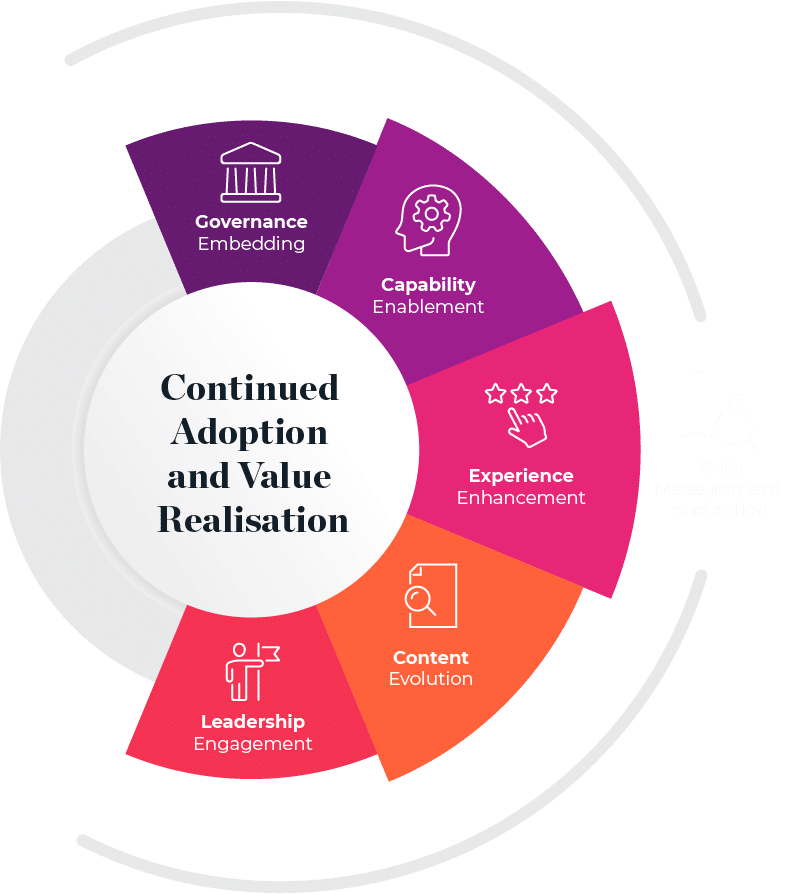Almost two-thirds of leaders consider improving employee experience a long-term transformation priority.1 One way to drive this is by implementing an engagement platform – a space for teams to come together to connect, communicate and collaborate. This need is increasingly important in today’s global and hybrid working environments, where only 21% of employees are engaged (2024), with clear implications on productivity, experience and overall workplace satisfaction.2
But successfully launching a new employee engagement platform is really just the beginning. Next comes the hard part: making it stick.
You’ve launched your platform. Now what?
Our Transformation Index found that 82% of organisations find it challenging to shift established behaviours and ways of working – so the real challenge is turning your platform into a daily habit, not a forgotten tool.1 The formula for driving adoption and making it a platform your team really use isn’t a one-off transformation project, it’s a continuous effort across multiple fronts.
So, what’s the formula for making it stick?

1. Embed governance
A great platform experience starts with strong governance. Without it, your platforms will drift into chaos or irrelevance.
This means defining clear roles – who owns the platform, manages content and responds to issues. Aligning global and local communications teams is important, so that messaging is consistent but also locally relevant. It’s also about protecting your people and your business: putting in place smart processes for moderation, incident response, data privacy and compliance.
This is essential strategic infrastructure – our research found that 65% of leaders say governance and compliance is a long-term focus, not just a short-term fix.1 And great governance enables trust, consistency and resilience, particularly if you’re scaling across markets.
2. Enable capability
64% of leaders say they struggle to shift behaviours and create psychological safety – people just won’t use something that is difficult to figure out or feels clunky.1 To drive adoption, make your platform feel effortless.
Offer short, practical learning moments that build confidence. Use nudges, incentives and recognition to reward engagement. Tailor support to different roles, markets and personas (because what works for one team won’t work for all). And activate a network of champions and influencers who can lead by example and help others get started.
Adoption will increase if your tools feel intuitive and valuable.
3. Enhance experience
A static platform quickly becomes invisible. Keep it fresh by listening to your users and testing new ideas. Almost three-quarters of smooth transformations regularly adjust based on employee feedback – so don’t just listen, always take action.1
Create an effective feedback loop and use persona-level insights to understand the distinct needs of different groups, then build a roadmap that reflects those needs. Evolve the platform alongside your wider channel strategy, so it feels integrated and not isolated.
When people see that the platform is responsive and improving to reflect their changing needs, they’re more likely to keep coming back.
4. Evolve content
Content is what brings your platform to life. It should reflect your culture, spark curiosity and feel meaningful and relatable to users. Use data to understand what’s landing (and more importantly, what’s not). Encourage user-generated content to build authenticity and community. And equip your teams with the tools, guidance and confidence to create inspiring, strategic content that connects with your people.
When content feels real and useful, you’ll see natural engagement follow.
5. Engage leadership
Leadership matters – leading organisations are twice as likely to prioritise leadership and talent than those lagging behind.1 In fact, 70% of team engagement is attributable to managers.2 If your leaders aren’t using the platform, how can you expect your employees to?
Start by assessing leadership engagement maturity – where are the gaps? Then build tailored coaching plans to help leaders understand how to use the platform to connect, recognise and lead. Gamification tools like leaderboards can add visibility and momentum.
6. Measure data
Data isn’t just about tracking – it’s about making informed decisions. Define clear success metrics that go beyond clicks and logins. Build dashboards that show what’s working for different personas. Use test-and-learn cycles to adapt quickly and turn insights into action with strategic reporting that tells a story.
When data drives decisions, your platform becomes a living part of your transformation strategy.
Adapt to act
Making your platform stick isn’t about one big push, it’s about building adaptability into every layer of your strategy. From governance to leadership, content to data, the organisations that succeed are those that treat engagement as a living system.
Looking to build employee engagement that truly lasts?
Get in touch to find out how we can help you build adaptability into every layer of your strategy.


